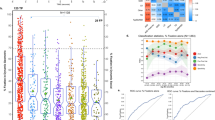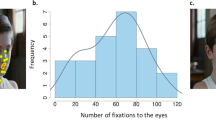Abstract
Girls with fragile X syndrome (FXS) often manifest significant symptoms of avoidance, anxiety, and arousal, particularly in the context of social interaction. However, little is currently known about the associations among neurobiological, biobehavioral such as eye gaze pattern, and social-cognitive dysfunction in real-world settings. In this study, we sought to characterize brain network properties and eye gaze patterns in girls with FXS during natural social interaction. Participants included 42 girls with FXS and 31 age- and verbal IQ-matched girls (control). Portable functional near-infrared spectroscopy (fNIRS) and an eye gaze tracker were used to investigate brain network alterations and eye gaze patterns associated with social-cognitive dysfunction in girls with FXS during a structured face-to-face conversation. Compared to controls, girls with FXS showed significantly increased inter-regional functional connectivity and greater excitability within the prefrontal cortex (PFC), frontal eye field (FEF) and superior temporal gyrus (STG) during the conversation. Girls with FXS showed significantly less eye contact with their conversational partner and more unregulated eye gaze behavior compared to the control group. We also demonstrated that a machine learning approach based on multimodal data, including brain network properties and eye gaze patterns, was predictive of multiple domains of social-cognitive behaviors in girls with FXS. Our findings expand current knowledge of neural mechanisms and eye gaze behaviors underlying naturalistic social interaction in girls with FXS. These results could be further evaluated and developed as intermediate phenotypic endpoints for treatment trial evaluation in girls with FXS.
This is a preview of subscription content, access via your institution
Access options
Subscribe to this journal
Receive 12 print issues and online access
$259.00 per year
only $21.58 per issue
Buy this article
- Purchase on Springer Link
- Instant access to full article PDF
Prices may be subject to local taxes which are calculated during checkout





Similar content being viewed by others

References
Lozano R, Azarang A, Wilaisakditipakorn T, Hagerman RJ. Fragile X syndrome: a review of clinical management. Intractable Rare Dis Res. 2016;5:145–57.
Bartholomay KL, Lee CH, Bruno JL, Lightbody AA, Reiss AL. Closing the Gender Gap in Fragile X Syndrome: Review on Females with FXS and Preliminary Research Findings. Brain Sci. 2019;9:2–14.
Garrett AS, Menon V, MacKenzie K, Reiss AL. Here’s looking at you, kid: neural systems underlying face and gaze processing in fragile XSyndrome. Arch Gen Psychiat. 2004;61:281–8.
Hall SS, Jiang H, Reiss AL, Greicius MD. Identifying large-scale brain networks in fragile X syndrome. JAMA Psychiatry. 2013;70:1215–23.
Lightbody AA, Reiss AL. Gene, brain, and behavior relationships in fragile X syndrome: evidence from neuroimaging studies. Dev Disabil Res Rev. 2009;15:343–52.
Watson C, Hoeft F, Garrett AS, Hall SS, Reiss AL. Aberrant brain activation during gaze processing in boys with fragile X syndrome. Arch Gen Psychiatry. 2008;65:1315–23.
Bruno JL, Garrett AS, Quintin EM, Mazaika PK, Reiss AL. Aberrant face and gaze habituation in fragile x syndrome. Am J Psychiatry. 2014;171:1099–106.
Cui X, Bray S, Bryant DM, Glover GH, Reiss AL. A quantitative comparison of NIRS and fMRI across multiple cognitive tasks. Neuroimage 2011;54:2808–21.
Ferrari M, Quaresima V. A brief review on the history of human functional near-infrared spectroscopy (fNIRS) development and fields of application. Neuroimage 2012;63:921–35.
Li R, Nguyen T, Potter T, Zhang Y. Dynamic cortical connectivity alterations associated with Alzheimer’s disease: An EEG and fNIRS integration study. Neuroimage-Clin. 2019;21:1–11.
Li R, Li S, Roh J, Wang C, Zhang Y. Multimodal neuroimaging using concurrent EEG/fNIRS for poststroke recovery assessment: an exploratory study. Neurorehab Neural Re. 2020;34:1099–110.
Cohen IL, Fisch GS, Sudhalter V, Wolf-Schein EG, Hanson D, Hagerman R, et al. Social gaze, social avoidance, and repetitive behavior in fragile X males: a controlled study. Am J Ment Retard. 1988;92:436–46.
Farzin F, Rivera SM, Hessl D. Brief report: Visual processing of faces in individuals with fragile X syndrome: an eye tracking study. J Autism Dev Disord. 2009;39:946–52.
Klusek J, Moser C, Schmidt J, Abbeduto L, Roberts JE. A novel eye-tracking paradigm for indexing social avoidance-related behavior in fragile X syndrome. Am J Med Genet B Neuropsychiatr Genet. 2020;183:5–16.
Hessl D, Harvey D, Sansone S, Crestodina C, Chin J, Joshi R, et al. Effects of mavoglurant on visual attention and pupil reactivity while viewing photographs of faces in Fragile X Syndrome. PLoS One. 2019;14:e0209984.
Hagerman RJ, Berry-Kravis E, Hazlett HC, Bailey DB Jr, Moine H, Kooy RF, et al. Fragile X syndrome. Nat Rev Dis Prim. 2017;3:17065.
Elliott CD, Salerno JD, Dumont R, Willis JO Differential ability scalesSecond edition. San Antonio, TX. 2007.
Constantino JN, Gruber CP Social Responsiveness Scale Second Edition (SRS-2): Manual: Western Psychological Services (WPS); 2012.
Gioia GA, Isquith PK, Guy SC, Kenworthy L BRIEF-2: Behavior rating inventory of executive function: Psychological Assessment Resources Lutz, FL; 2015.
Li R, Bruno JL, Jordan T, Miller JG, Lee CH, Bartholomay KL, et al. Aberrant Neural Response During Face Processing in Girls with Fragile X Syndrome: Defining Potential Brain Biomarkers for Treatment Studies. Biol Psychiatry Cogn Neurosci Neuroimaging. 2021. (in press)
Esbensen AJ, Rojahn J, Aman MG, Ruedrich S. Reliability and validity of an assessment instrument for anxiety, depression, and mood among individuals with mental retardation. J Autism Dev Disord. 2003;33:617–29.
Berry-Kravis E, Doll E, Sterling A, Kover ST, Schroeder SM, Mathur S, et al. Development of an expressive language sampling procedure in fragile X syndrome: a pilot study. J Dev Behav Pediatr. 2013;34:245–51.
Hall S, DeBernardis M, Reiss A. Social escape behaviors in children with fragile X syndrome. J Autism Dev Disord. 2006;36:935–47.
Grinsted A, Moore JC, Jevrejeva S Application of the cross wavelet transform and wavelet coherence to geophysical time series.Nonlinear Process Geophys 2004;11:561–66.
Cui X, Bryant DM, Reiss AL. NIRS-based hyperscanning reveals increased interpersonal coherence in superior frontal cortex during cooperation. Neuroimage 2012;59:2430–7.
Rubinov M, Sporns O. Complex network measures of brain connectivity: Uses and interpretations. Neuroimage 2010;52:1059–69.
Breiman L. Random forests. Mach Learn. 2001;45:5–32.
Wang MY, Luan P, Zhang J, Xiang YT, Niu H, Yuan Z. Concurrent mapping of brain activation from multiple subjects during social interaction by hyperscanning: a mini-review. Quant Imaging Med Surg. 2018;8:819–37.
Mayseless N, Hawthorne G, Reiss AL. Real-life creative problem solving in teams: fNIRS based hyperscanning study. Neuroimage 2019;203:116161.
Iacoboni M, Dapretto M. The mirror neuron system and the consequences of its dysfunction. Nat Rev Neurosci. 2006;7:942–51.
Frith CD, Frith U. The neural basis of mentalizing. Neuron 2006;50:531–4.
Schall JD. On the role of frontal eye field in guiding attention and saccades. Vis Res. 2004;44:1453–67.
Murphy MM, Abbeduto L, Schroeder S, Serlin R. Contribution of social and information-processing factors to eye-gaze avoidance in fragile X syndrome. Am J Ment Retard. 2007;112:349–60.
Farzin F, Scaggs F, Hervey C, Berry-Kravis E, Hessl D. Reliability of eye tracking and pupillometry measures in individuals with fragile X syndrome. J Autism Dev Disord. 2011;41:1515–22.
Lesniak-Karpiak K, Mazzocco MM, Ross JL. Behavioral assessment of social anxiety in females with Turner or fragile X syndrome. J Autism Dev Disord. 2003;33:55–67.
Carlen M. What constitutes the prefrontal cortex? Science 2017;358:478–82.
Radua J, Phillips ML, Russell T, Lawrence N, Marshall N, Kalidindi S, et al. Neural response to specific components of fearful faces in healthy and schizophrenic adults. Neuroimage 2010;49:939–46.
Bigler ED, Mortensen S, Neeley ES, Ozonoff S, Krasny L, Johnson M, et al. Superior temporal gyrus, language function, and autism. Dev Neuropsychol. 2007;31:217–38.
Dalton KM, Holsen L, Abbeduto L, Davidson RJ. Brain function and gaze fixation during facial-emotion processing in fragile X and autism. Autism Res. 2008;1:231–9.
Gothelf D, Furfaro JA, Hoeft F, Eckert MA, Hall SS, O’Hara R, et al. Neuroanatomy of fragile X syndrome is associated with aberrant behavior and the fragile X mental retardation protein (FMRP). Ann Neurol. 2008;63:40–51.
Budimirovic DB, Berry-Kravis E, Erickson CA, Hall SS, Hessl D, Reiss AL, et al. Updated report on tools to measure outcomes of clinical trials in fragile X syndrome. J Neurodev Disord. 2017;9:14.
Bruno JL, Hosseini SH, Lightbody AA, Manchanda MK, Reiss AL. Brain circuitry, behavior, and cognition: a randomized placebo-controlled trial of donepezil in fragile X syndrome. J Psychopharmacol. 2019;33:975–85.
Acknowledgements
We thank the families who participated in this study and many members of the laboratory who assisted with this project. This work was supported by National Institute of Mental Health Grant Nos. R01MH050047 and T32MH019908 (to A.L.R.), the Kelvin Foundation and the Canel Family Fund.
Author information
Authors and Affiliations
Contributions
RL conceived the idea, preprocessed the data, performed the main analysis, and wrote the article. JB, CL and KB collected the data and revised the article. JS and AP preprocessed the eye tracking data and revised the article. TJ, JG and AL conceived the idea and revised the article. AR obtained funding, conceived the idea, and critically revised the article.
Corresponding author
Ethics declarations
Competing interests
The authors declare no competing interests.
Additional information
Publisher’s note Springer Nature remains neutral with regard to jurisdictional claims in published maps and institutional affiliations.
Supplementary information
Rights and permissions
About this article
Cite this article
Li, R., Bruno, J.L., Lee, C.H. et al. Aberrant brain network and eye gaze patterns during natural social interaction predict multi-domain social-cognitive behaviors in girls with fragile X syndrome. Mol Psychiatry 27, 3768–3776 (2022). https://doi.org/10.1038/s41380-022-01626-3
Received:
Revised:
Accepted:
Published:
Issue Date:
DOI: https://doi.org/10.1038/s41380-022-01626-3


